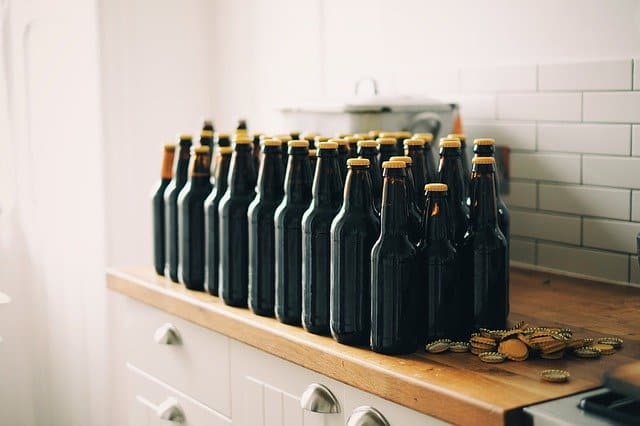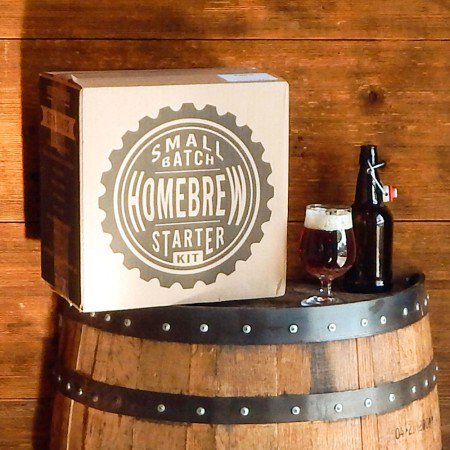When we talk about homebrewing beer you’ll usually see a reference to five gallon batches. However, there are several reasons you might want to start getting into brewing on a smaller scale. Especially, when it comes to the cost and space savings of small batch brewing equipment.
Small batch beer brewing whether it be half batch brewing or one gallon batches has some great advantages. The small batch (especially one gallon beer recipes) are tailored for urban homebrew enthusiasts who live in smaller spaces, but brewing by the gallon could have advantages for everyone.
Small Batch Brewing Kits To Start Brewing Quickly
Why You Might Want to Get Into Small Batch Beer Brewing
1. It’s Easier To Brew In Your Kitchen
If you’ve been brewing outside or in your garage you may be in for a sweet surprise. Especially, if you have to brew in inclement weather or unfriendly climates. Because the equipment is not as bulky when you’re half batch brewing or brewing in gallon batches you can easily brew in your kitchen.
In fact, some of the equipment you may already be in your kitchen. If you already have a large pot you can use that for a brew kettle. However, there are brew kettles you can purchase for any batch size. But you’ll likely also have a mesh strainer, funnels and ice cube trays or ice packs to cool the wort. Nobody wants to move 50 pounds of equipment loaded with beer such as a fermenter. The equipment required to brew a gallon at time in your kitchen is a lot lighter and easier to handle.
2. Experiment With Different Recipes With More Variety
You can experiment with different recipes more often by cooking with a one gallon recipe rather than the larger batches. There are even Early American recipes where they worked to continually perfect their beer.
When brewing in small batches you’re not committing to make so much beer as you would with a five gallon brew. This allows you to experiment with a new brew every couple of weeks if you wanted to finish one brew before starting another. If you like to experiment or like to dive into seasonal beers small batch brewing is great for you.
3. Less Storage for Small Batches
Homebrewing in smaller batches is a great space saver. Especially, if you have a smaller home or apartment. Brewing one gallon recipes will brew about 10 bottles per batch. This brings the brewed batch under the amount of beer you can buy at any grocery store, and the final brew can fit nicely in your fridge. Also, you won’t need to worry about where to store all of the bulky equipment a five gallon brew requires.
4. Scalability for Recipes
Most recipes give directions to brew five gallons of beer, but you can scale batches down to as small as one gallon. Because of this you would need to either cut the recipe in fifths if you are brewing a gallon or in half if you are brewing 2.5 gallons. The only ingredient that does not need to be scaled down is the beer yeast. Any batch less than 5 gallons still uses 5 gallons worth of yeast.
5. Small Batch Homebrew Requires Less Money
This one is actually a pretty simple one, but there are a few more things to be said about brewing in smaller batches. The obvious part is you will spend less money on ingredients like grain because you will not need as much of it. However, you can still save a lot of money but splurge a little more on some higher end materials such as maple syrup or honey. Going all-grain at this point can give the beer more complex and interesting flavors.
6. You Can Practice Your Brewing Techniques
If you’re brewing for the first time this is the baby step you’ll want to take as you learn the ropes of homebrewing. It is never fun to spend your time, effort and money brewing a beer that you may have to throw away if it doesn’t turn out as planned. If you have brewed before than brewing beer in a smaller batch gives you the opportunity to try out different methods and techniques. In the end, you’ll be able to brew more often and learn new techniques faster.

7. Small Batch Brewing Means Shorter and Easier Brew Days
When you brew in small batches the process of heating and cooling happens much faster in a one gallon brew. But there are a lot of other benefits such as controlling the heat of the mash and strength of the boil. Since we’re working on a smaller scale the entire process is easier to manage. You can clock a brew in two hours or less instead of spending all night waiting for a 5 gallon batch to boil.
Here’s what you can expect time wise when you brew in a smaller batch:
- Brew Day: Approximately 3 Hours
- Fermentation: Approximately 2 Weeks
- Secondary Fermentation: Approximately 2 Weeks
- Total Time: Approximately 4 Weeks
8. Better Quality and Taste in Small Batches
You may also notice a better quality and better taste in your brews as you have more control over the process. For example, there will be better temperature regulation of the mash and a full rolling boil when adding the hops. The yeast will also cool down quicker and when you add all of these elements together it makes for a better tasting beer.
Instead of using a malt you can also go to small batch all grain brewing. By going with 1 gallon all grain brewing you’ll have a lot of creative control with your beer. This leads to better flavors. Much like the good ‘ole cake recipe example brewing with malt would be like buying a box of cake mix. Whereas brewing s small batch all grain recipe will allow you to customize each ingredient to taste.
9. Cleaning is Easier and quicker
With large batch brewing the wet grain waste can easily be 15 to 30 pounds. Even if you have a large space that waste is a lot to deal with. A small batch brew only generates about 3 to 5 pounds of waste. Than it comes to cleaning equipment itself. Many of your small batch brewing supplies can fit right in your dishwasher to really help make cleanup simple. Lastly, small batch beer brewing means that you have an easier time keeping things sanitized. This can also help with the quality of your homebrewed beer.
Small Batch Brewing Equipment
Small scale brewing equipment is a lot easier to come by now than it used to be. There are a lot of small batch brewing kits available now to allow you to get started quickly. Here’s a list of small batch brewing equipment you need followed by some small batch home brew kits you can grab off the shelf and be ready to go.
| Brew Stage | Must Have | Nice To Have |
|---|---|---|
| Preparation | Cleaner: Need to use something without perfumes like PBW so nothing impacts the taste of your beer. | |
| Preparation | Sanitizer: Different than cleaner. Make sure you kill germs and not just remove visible dirt. Recommended Product: Star San Brewing Sanitizer | |
| Preperation | Food Grade Bucket: This will help you with cleaning and sanitizing. | |
| Preperation | Brewers Gloves: Although you can brew beer without gloves it’s highly recommended. They’ll protect against heat and chemicals during cleaning and sanitizing. | |
| Brewing | Stock Pot: You might already have a large enough stock pot at home. | Brew Kettle: Read this brew kettle guide to see good kettle options and what size you need for your batch size. |
| Brewing | Wort Chiller: Technically you can use an ice bath, but cooling wort fast is so important that I say this is a must have. If you don’t cool wort fast enough you can ruin your beer. You can use an immersion chiller or other wort chiller options. | |
| Brewing | Digital Thermometer: Very important since controlling temperatures is crucial. | |
| Brewing | Large Slotted Spoon: Should be metal since wood spoons are difficult to sanitize. | |
| Brewing | Digital Kitchen Scale: Like many recipes it’s important to be accurate with ingredients. Many parts of homebrewing uses weights as measurements so a scale is important | |
| Fermentation | Hydrometer: To measure the alcohol content before and after fermentation. | Refractometer: A step up from a hydrometer. It can measure gravity with only a few drops instead of needing 6-8 ounces of liquid like the hydrometer. |
| Fermentation | 2-Gallon Primary Fermentation Bucket: For primary fermentation | Mini Auto Siphon: Makes siphoning from primary fermentation bucket to the glass carboy much easier. |
| Fermentation | One Gallon Glass Carboy: Get it with a rubber stopper for secondary fermentation. Note: If you skip secondary fermentation you should use glass as the primary fermentation vessel. | Conical Fermenter: Gives a cleaner beer with no need to siphon. |
| Fermentation | Food Grade Vinyl Tubing: You’ll need this to transfer the beer between vessels. | |
| Bottling/Kegging | Beer Bottles: If you choose to bottle your beer you’ll obviously need the bottles. | Bottle Filler: If you bottle your beer this is an inexpensive item to make bottling much easier. |
| Bottling/Kegging | Manual Bottle Capper: This will make capping and getting an air tight seal much easier. Note: This capper in the link also comes with 144 caps included. | |
| Bottling/Kegging | Priming Sugar Tablets: Add these to the bottle when filling and it will give you the carbonation you need. | |
| Bottling/Kegging | Kegs: If you don’t want to bottle your beer you can always keg your beer. | Pressurized Growler: This can come in handy if you want to transport your beer to share with friends. |
Is Small Batch Beer Brewing Right for You?
In the end, the batch size is a matter of personal preference and is not right for everyone. But in many circumstance small batch beer brewing yields a lot of benefits over brewing in larger batches. It isn’t about the scale in which you brew as much as you’re able to have fun making your brew. No matter the size of brew you choose.
You also need to consider all of the small batch brewing equipment you’ll need. It seems like a lot of stuff, but you should also remember that much of this equipment is on a smaller scale than the equipment needed to brew 5 gallon batches.

